7 Insects That Are Beneficial to Tomato Plants
It may not be necessary to rely on an insecticide – a chemical spray – to destroy those pests that are harmful to your tomato plant crop. There are beneficial insects just waiting to get to work!
Only around 2% of the entire insect populace does, in fact, cause destruction to tomato plants. While there are a handful of insects that are good because they like to feast on the destructive ones.
There are many insecticides currently sold on the market that will kill the bad bugs. But these insecticides also kill the good bugs. For obvious reasons, that’s not at all what we want. It’s a one-size-fits-all insecticide scenario that is best avoided.
Moving on, here are 7 of the most common insects that are beneficial for tomato plants and for many other plants in the garden.
I’ve also made mention of a number of plants you can grow in your garden to attract the ‘beneficials’.
Beneficial Insect # 1: Lady Beetles / Ladybugs
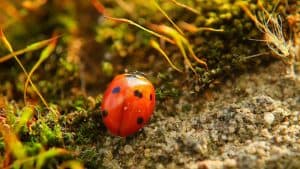
(This post may contain links to products. Please make the assumption that at least some of the links may result in earning commissions. Thank you.)
Perhaps you grew up referring to these lovely little creatures as ladybugs. In fact, they are beetles rather than bugs.
Lady beetles are prolific at feeding on soft-skinned insects inclusive of aphids, whitefly, mealy bugs, thrips, scale insects, and mites.
The lady beetle larvae, as well as the adult, devour all of those destructive insects in plentiful numbers.
Some garden centers and many websites, including Amazon, offer live lady beetles for sale.
1,500 Live Ladybugs (lady beetles) for sale on Amazon
Beneficial Insect #2: Lacewings
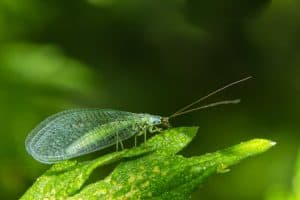
Lacewings have a rather fitting nickname: ‘Aphid Lion’. However, many adult species of this lacewing don’t actually eat insects. They ‘prefer’ honeydew, pollen, and nectar as a source of food.
It’s not the adult lacewing that’s the prolific hunter – it’s their children and when the children are merely larvae.
Every individual lacewing larva is capable of consuming around 200 insects per week. So it’s well worth encouraging lacewings to your yard.
Beneficial Insect #3: Assassin Bugs
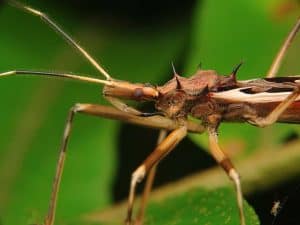
Perhaps because of its rather deadly appearance, some people ask:
“Can assassin bugs kill you?”
“Are assassin bugs harmful to humans?”
“Are assassin bugs good?”
And the answers to those questions, are:
Yes, assassin bugs can harm you as a human. Their bite is a bit painful.
No, assassin bugs will not kill you – again, as a human.
Yes, assassin bugs are good, unless you’re an aphid or a caterpillar (both of which are harmful to tomato plants) or one of many other insect species, including the lady beetle.
Beneficial Insect #4: Minute Pirate Bug

Minute pirate bugs, as the name suggests, are tiny insects – typically around one-fifth of an inch in length. You may recognize them because of their color (if you can see them). They are dark purple or black with white markings toward the wingtips.
These little creatures may be very small but they more quickly and have a very predatory instinct. They feed on aphids, thrips, spider mites, and other plant-harming insects. They also feed on plants that are nicely tender by sucking leave sap. The damage, though, is minimal.
Minute pirate bugs can give you a bit of a nip too. The bite, though, will typically involve only a little bit of irritation on a temporary basis.
Beneficial Insect #5: Praying Mantis
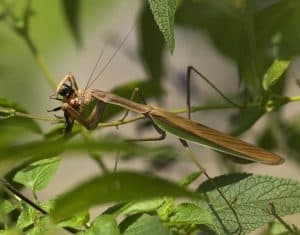
The praying mantis is a generalized-type predator. It will happily devour most pest insects, as well as their eggs, and mites too. Each egg cocoon consists of around 200 baby mantis so you don’t need many eggs to have a whole army of praying mantis helping out your tomato plants and your entire garden.
Praying mantis is the only insect (that is known about) to be able to turn its head so as to look over its shoulder. They lie in wait for their prey, snapping it up with lightning speed.
Fortunately for us, manti have voracious appetites and they will devour aphids, caterpillars, leafhoppers, mosquitoes, and a whole host of other soft-bodied insects and larvae.
When they are more developed, manti will also consume grasshoppers, crickets, and other pests known to inhabit the garden.
Beneficial Insect #6: Big-Eyed Bug
Big-eyed bugs are found across the U.S. and in Canada. They feed on numerous insect pest varieties including leafhoppers, whitefly, aphids, caterpillars, mites, and thrips.
Generally, big-eyed bugs are benevolent in nature aiding the gardener to combat an array of pest insects. Nevertheless, should prey numbers drop significantly, big-eyed bugs will then resort to sap-sucking activities, and that sap-sucking activity will include tomato plants.
The organic garden, though, typically will have plenty of temptation in the form of ‘delicious’ pest insects on the menu. So big-eyed bug sap-sucking will more than likely be kept to an absolute minimum.
Beneficial Insect #7: Rough Stink Bug
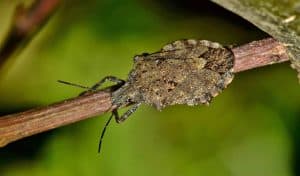
Fortunately, not all stink bugs are harmful to plants. The Rough stink bug is your friend in the garden and they feed on more than 100 different insect pest species.
The nymphs, as well as the adults, go for insects that are larger in size than themselves. They suck the prey’s body fluids using their needle-like beak.
Rough stink bugs feed on beetle plant-eating larvae, on adult beetles, on caterpillars, aphids, and various other soft-bodied insects.
How to Attract Beneficial Insects to Your Yard?
Easy enough: incorporate the sort of plants that attract beneficial insects within your planting schemes.
This brief list of flowers and herbs will serve to attract beneficial insects to your yard. They will also cater to active pollinators and provide culinary herbs for the kitchen.
- Cilantro
- Dill
- Yarrow
- Angelica
- Corriander
- Fennel
- Queen Anne’s lace (Daucus carota)
- Cosmos
- Marigolds
- Sulfur cinquefoil (Potentilla recta ‘warrenii’)
- Sunflowers
- Rocky Mountain penstemon (Penstemon strictus)
- Tansy
- Spearmint
- Caraway (Carum carvi)
- Parsley
- Zinnia
- Dandelion (yes, the weed)
If you do wish to utilize a pesticide be sure you know exactly what you wish to eradicate with it. Rather than using a broad-spectrum type insecticide that will kill insect pests and beneficials without any discrimination, instead opt for insecticidal soaps and horticultural oils. These are much more friendly to beneficials in the garden.
By all means, try to tolerate any mild insect infestations in your yard. Allow the beneficial insects some time to multiply in numbers. After that, they will help to tackle the problem for you.
Place a water feature or a birdbath in your garden. This will help to attract a large variety of beneficial insects in addition to another voracious insect predator – birds.



12 thoughts on “7 Beneficial Insects for Tomato Plants”